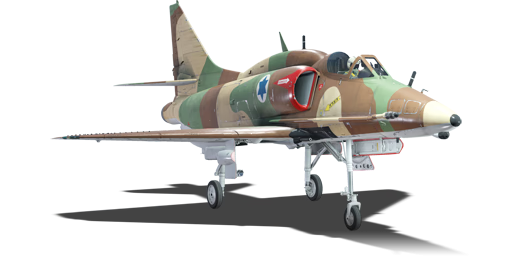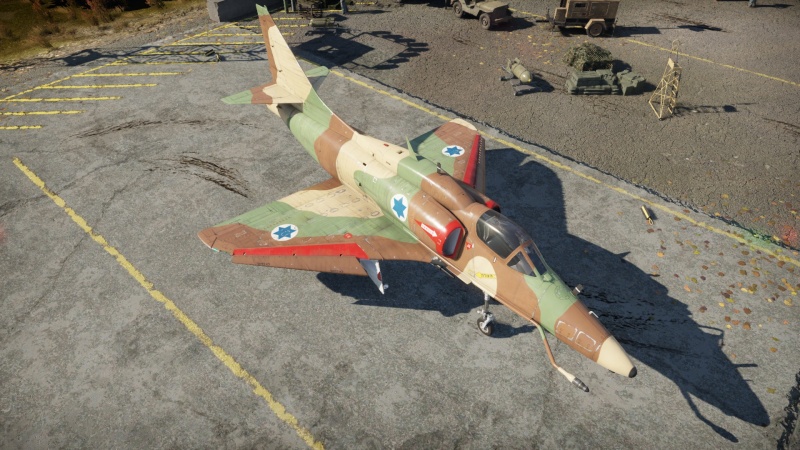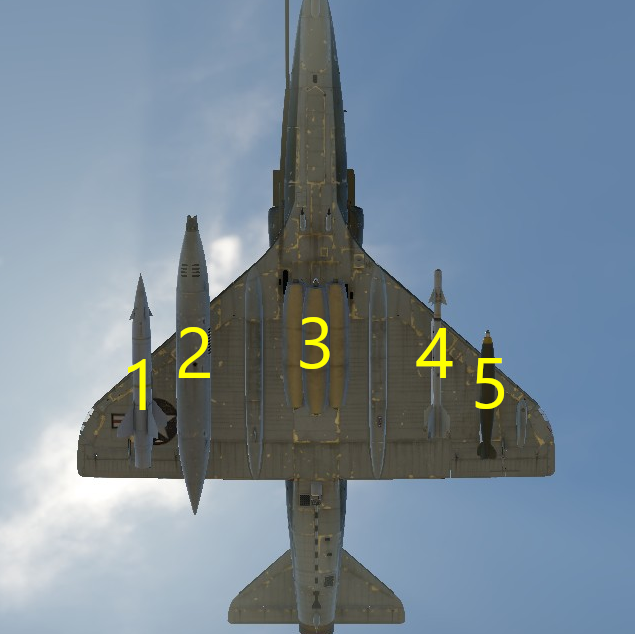Ayit
Contents
Description
In the 1980s, Israel set out to upgrade their A-4 Skyhawk fleet and modernize it. The upgrade package chosen would allow their A-4s to reach a level of equivelance to the US Marine Corps A-4M models. The resulting variant, called the A-4N "Ayit" included the integration of the Elbit ACE-1 HUD, Elbit computers, and the installation of an Elta EL/M-2032 radar, significantly enhancing its air-to-air and air-to-ground capabilities. The A-4N Ayit could carry advanced munitions like the later variants of the AIM-9 Sidewinder and AGM-65 Maverick missiles, making it a potent platform for precision strike missions. IAI (Israel Aircraft Industries) conducted these upgrades, transforming the aging A-4 into a highly capable and modern combat aircraft, which served the IAF until its retirement in the early 2000s. The A-4N Ayit remains a testament to Israel's expertise in aircraft modernization and adaptation.
The A-4N Skyhawk II (Ayit), introduced in Update "Winged Lions", is the most advanced Skyhawk variant in War Thunder. The aircraft is a serious powerhouse in mixed battles thanks to its incredible air-to-air and even more impressive air-to-ground performance. Being fitted with a more powerful engine and a larger arsenal of AAMs and AGMs over other Skyhawks, it can absolutely tear apart teams at its battle rating when used right. It can equip dangerous infrared missiles for air combat and has early access to AGM-65A Maverick air-to-ground missiles for tank busting, easily outranging most anti-air systems at its battle rating. The Ayit however does have serious shortcomings in dedicated air battle modes, due to regularly facing supersonic aircraft and aircraft with countermeasures at its battle rating which can easily counter the Ayit's main tricks. It is advised to play defensively and opportunistically in these modes with the Ayit, preying on any distracted or lonely fighters that underestimate you.
General info
Flight performance
| Characteristics | Max Speed (km/h at 1,524 m) |
Max altitude (metres) |
Turn time (seconds) |
Rate of climb (metres/second) |
Take-off run (metres) | |||
|---|---|---|---|---|---|---|---|---|
| AB | RB | AB | RB | AB | RB | |||
| Stock | 1,092 | 1,083 | 12500 | 32.5 | 33.8 | 51.4 | 50.7 | 1,000 |
| Upgraded | 1,117 | 1,105 | 31.5 | 32.0 | 83.8 | 67.0 | ||
Details
| Features | |||||
|---|---|---|---|---|---|
| Combat flaps | Take-off flaps | Landing flaps | Air brakes | Arrestor gear | Drogue chute |
| ✓ | ✓ | ✓ | ✓ | ✓ | ✓ |
| Limits | ||||||
|---|---|---|---|---|---|---|
| Wings (km/h) | Gear (km/h) | Flaps (km/h) | Max Static G | |||
| Combat | Take-off | Landing | + | - | ||
| 1,167 | 437 | 592 | 563 | 410 | ~8 | ~3 |
| Optimal velocities (km/h) | |||
|---|---|---|---|
| Ailerons | Rudder | Elevators | Radiator |
| < 450 | < 700 | < 490 | N/A |
Engine performance
| Engine | Aircraft mass | ||||||
|---|---|---|---|---|---|---|---|
| Engine name | Number | Basic mass | Wing loading (full fuel) | ||||
| Pratt & Whitney J52-P-408 | 1 | 5,055 kg | 311 kg/m2 | ||||
| Engine characteristics | Mass with fuel (no weapons load) | Max Takeoff Weight | |||||
| Weight (each) | Type | 10m fuel | 20m fuel | 30m fuel | 36m fuel | ||
| 1,052 kg | Axial-flow turbojet | 5,795 kg | 6,421 kg | 7,104 kg | 7,523 kg | 11,113 kg | |
| Maximum engine thrust @ 0 m (RB/SB) | Thrust to weight ratio @ 0 m (100%) | ||||||
| Condition | 100% | WEP | 10m fuel | 20m fuel | 30m fuel | 36m fuel | MTOW |
| Stationary | 4,516 kgf | N/A | 0.78 | 0.70 | 0.64 | 0.60 | 0.41 |
| Optimal | 4,516 kgf (0 km/h) |
N/A | 0.78 | 0.70 | 0.64 | 0.60 | 0.41 |
Survivability and armour
Like all other Skyhawks, the survivability is very poor. The aircraft was designed around the idea of being small and lightweight, which translates to easily taking damage. The two fuel tanks in the wings are not self-sealing and almost always take damage when either wing is hit. The fuel tank behind the pilot is a very large target but does have self-sealing capabilities.
The pilot is well-protected by the standards of many other fighters but that protection is still extremely poor. 2.54mm of steel protects the front, sides, and bottom of the pilot; the rear of the cockpit is unarmoured. The front windshield panel contains 50mm of bulletproof glass.
The first time the Ayit takes damage is usually the last time, as any damage to the airframe either completely knocks out the aircraft or hampers its flight performance so badly the aircraft will either crash or be easy prey for the next attack. The Ayit can get away with taking some stray machine gun fire from tanks in mixed battles but any kind of dedicated surface-to-air or air-to-air weaponry will tear it apart.
Another issue for the aircraft is how easily the wings break, especially when carrying heavier air-to-ground weapons. Any speed over about 650 km/h and the wings will snap with the first hard roll or turn. This is a problem for all Skyhawks but, given how much more powerful the Ayit's engine is, it will be a constant source of concern.
Modifications and economy
Armaments
| Ballistic Computer | |||
|---|---|---|---|
| CCIP (Guns) | CCIP (Rockets) | CCIP (Bombs) | CCRP (Bombs) |
| |
|
|
|
Offensive armament
The Ayit is armed with:
- 2 x 30 mm DEFA 553 cannons, belly-mounted (150 rpg = 300 total)
- 60 x countermeasures
Suspended armament
The Ayit can be outfitted with the following ordnance:
| 1 | 2 | 3 | 4 | 5 | ||
|---|---|---|---|---|---|---|
| 20 mm Mk 11 mod 5 cannons (750 rpg) | 1 | 1 | 1 | |||
| 250 lb LDGP Mk 81 bombs | 1 | 6 | 6 | 6 | 1 | |
| 250 lb Mk 81 Snakeye bombs | 1 | 6 | 6 | 6 | 1 | |
| 500 lb LDGP Mk 82 bombs | 1 | 3 | 6 | 3 | 1 | |
| 500 lb Mk 82 Snakeye bombs | 1 | 3 | 6 | 3 | 1 | |
| 750 lb M117 cone 45 bombs | 1 | 1 | 1 | |||
| 1,000 lb LDGP Mk 83 bombs | 1 | 3 | 1 | |||
| 2,000 lb LDGP Mk 84 bombs | 1 | 1 | 1 | |||
| 510 kg AGM-62A Walleye I ER bombs | 1 | 1 | ||||
| 2,000 lb GBU-8 bombs | 1 | |||||
| BLU-27/B incendiary bombs | 1 | 1 | 1 | 1 | 1 | |
| FFAR Mighty Mouse rockets | 19 | 38 | 57 | 38 | 19 | |
| Zuni Mk32 Mod 0 ATAP rockets | 4 | 8 | 12 | 8 | 4 | |
| AGM-12B Bullpup missiles | 1 | 1 | 1 | 1 | ||
| AGM-65A missiles | 3 | |||||
| AIM-9D Sidewinder missiles | 1 | 1 | ||||
| Shafrir 2 missiles | 1 | 1 | 1 | 1 | ||
| Maximum permissible weight imbalance: 1,000 kg | ||||||
| Default weapon presets | |
|---|---|
| |
Ayit's arsenal is a massive upgrade compared to the previous Israeli A-4E. Plenty of unguided bombs and rockets are available as usual, and the ballistic computer now offers CCIP on top of the existing CCRP capability. However it still lacks CCIP for rockets, so the Ayit is not a first-rate rocket sled despite having a large capacity for rocket pods.
Two options are available for air-to-air ordnance, the domestic Shafrir 2 missile and the American AIM-9D, much improved over the A-4E's AIM-9B Sidewinders. Both have overloads of 18 G, which is very good for its battle rating, and enemies will need to put significant effort into dodging them kinetically. The AIM-9D has a better seeker and somewhat longer range while the Shafrir 2 offers an uncaged seeker. The Sidewinder will be the best choice for higher altitudes and longer ranges while the Shafrir will serve best in closer-range dogfights where the uncaged seeker really shines.
Air-to-ground capability is where the Ayit truly comes into its own. MCLOS Bullpup missiles will provide experienced pilots with a hard-hitting, precision ground strike capability. AGM-62A Walleye and GBU-8 TV-guided glide bombs allow fire-and-forget bombing, while the triple rack of AGM-65A Mavericks gives pilots an extremely powerful weapon against any armoured ground target. Although less powerful than the later AGM-65B and AGM-65D, they are the lowest BR Mavericks in the game.
Usage in battles
The Ayit can be used in a multitude of roles such as a fighter, bomber, or ground attacker due to its variety of armaments and good performance.
Fighter
Players that plan to use it as a fighter will not be disappointed by its air-to-air armament. Mounted with 2 x 30 mm DEFA cannons, gun kills will be quick and simple, but users should be aware of the DEFA's limited range. There is also an option for up to three 20 mm gunpods which can be mounted on either wing and/or centerline of the aircraft. The wing-mounted gunpods will take up valuable missile slots, so players who wish for a bit more firepower against aircraft should equip only the center-line gunpod. The Ayit has access to two different air-to-air missiles, the Shafrir 2 and the AIM-9D. Both missiles are very good for the battle rating and the best loadout will be the 2x Shafrir 2 and 2x AIM-9D. Shafrir 2's should be used for close range and slower targets as these missiles can be kinematically evaded by manoeuvrable fighters like the MiG-17 or MiG-19. Shafrir 2's also have an uncaged seeker which can be utilized for leading the missile which helps in close-range launches. On the other hand, the AIM-9D does not have an uncaged seeker which is a detriment in close-range launches but the missile can hit longer-range targets and is incredibly hard to kinematically evade. For the best performance against aircraft, players should choose the low-fuel option to reduce the chance of overloading the wings and to stay light as possible. The Ayit also has countermeasures so missiles like the AIM-9G and R-60 can be easily evaded. Because of its strong engine, the Ayit can accelerate very well. However, due to the delta wing design, it will quickly lose energy with extensive turning so players should be wary of getting into prolonged fights.
Attacker/Bomber
For ground attacks and bombing, the Ayit has a lot of options. From air-to-ground missiles, guided bombs, and regular dumb bombs and rockets, players can equip a variety of weapons with custom loadouts. The dumb bombs have CCIP/CCRP which will allow for accurate drops but the rockets and cannons do not. For bombing, the dumb bombs will give the most tonnage but the BLU-27 incendiary bombs can also be used to take out bases. Players who plan to ground attack in Air RB should note the map before spawning in. Some maps (City) have simple models for ground vehicles which can easily be taken out by either the 30 mm or 20 mm cannon. However, many new maps (Sinai, Vietnam, etc) have detailed ground vehicles that will require more than just cannons to take out. For those targets, the best option would be to use guided weaponry, dumb bombs, or rockets if one is accustomed to using them. Against stationary ground targets like AA or light pillboxes, the cannons will easily destroy them.
Common Enemies
The F-104A is a common foe for the Ayit. It is the same battle rating in realistic battles as the Ayit and is a popular plane due to its immense speed. However, the F-104A struggles with maneuverability, so Ayit users can reverse a Starfighter and quickly get on their six for a quick window to get a missile off. If an Ayit user is unable to fire a missile off then it will be best to go back to level flight and try to run to a friendly or wait for another reversal attempt. This same process applies to many other flareless supersonic fighters like the MiG-21F/S and MiG-19. Unlike the Starfighter, both of these planes are more manoeuvrable and can be a bit more difficult to get a reversal done. As for subsonic jets like the F-86F-2 or MiG-17, the Ayit can use its quick acceleration and top speed to run away or get into a better position for a dogfight. Reversals can also be done against these targets due to the Ayit's ability to quickly bleed energy but these should not be performed with multiple enemies around. It will also be much more difficult to do this maneuver since subsonic aircraft will have a far lower closure rate compared to supersonic jets. The Ayit will also struggle in vertical fights due to how quickly it will lose energy compared to planes like the MiG-17. Players should try and avoid these types of fights whenever possible.
Pros and cons
Pros:
- Has access to a large variety of mixed loadouts, including AGM-65 Mavericks and superior AIM-9D/Shafrir 2 missiles
- Has the strongest engine among all Skyhawks in-game which allows it to accelerate very well
- Hard-hitting DEFA 553 cannons with a lot of ammunition
- Excellent roll rate and turn rate
- Has access to RWR, flares, and chaff
Cons:
- Wings rip very easily during high-G turns
- No CCIP for the guns or rockets
- DEFA 553 cannons have rather low muzzle velocity, which makes them harder to aim than most guns
- Aircraft performance can become unresponsive when carrying heavy loadouts
- Very average top speed which quickly becomes outclassed in uptiers
History
In the years between 1972 and 1976, Israel received 117 upgraded A-4Ms called the A-4N. The A-4N ("Ayit" which means eagle) received many updated avionics over the standard A-4M while retaining the J52-P-408 engine. These updates included new computers, a heads-up display, a mapping, and range radar (AN/APQ-145), ECM homing and warning receiver (AN/APR-36/37), and more. The A-4N also received 2 DEFA 30 mm cannons, unlike the A-4M which had 2 20 millimeter cannons. In addition, the cockpit was revised for better visibility.
In 1968, Israel launched a program to upgrade the Super Mystere with the Pratt & Whitney J52 to replace the original Atar 101. This program was launched in order to make the Super Mystere more similar to the A-4 Skyhawks Israel had at the time which also had the J52. In order to fit the J52, major structural redesigns were needed and one of these changes included an extension of the tailpipe. During the Yom Kippur War in 1973, a year after Israel started receiving A-4Ns, Israeli officials noticed that although the upgraded Super Mysteres and A-4Ns flew almost the exact same type of missions and faced the same type of enemies, fewer Super Mysteres were being lost to missiles than the A-4Ns. Further analysis proved that the extension of the tailpipe from the upgraded Super Mystere moved the missile's detonation further away from the aircraft, thus leading to less damage and a lower loss rate. The A-4N was recommended to receive a similar type of tailpipe which is why A-4Ns after 1973 have an extended tailpipe. Israel continued using the A-4N until it was fully retired in 2015, 43 years after it was introduced into service.
A few A-4Ns were acquired by Top Aces and Draken International. Draken International, a US-based company, provided training for the Air National Guard with their acquired A-4Ns. Top Aces has used A-4Ns for training the Canadian, Australian, and German armed forces.
Media
- Skins
See also
- Related development
External links
| Douglas Aircraft Company | |
|---|---|
| Strike Aircraft | A-20G-25 · A-26B-10 · A-26B-50 · AD-2 · AD-4 · A-1H |
| Bombers | TBD-1 · B-18A · SBD-3 · BTD-1 · A-26C-45 · A-26C-45DT |
| Turboprops | A2D-1 |
| Jet Aircraft | F3D-1 · F4D-1 |
| A-4 Skyhawk | A-4B · A-4E Early |
| Export | ▄Havoc Mk I · ▄Boston Mk I · ▄DB-7 · ▂A-20G-30 · ▄AD-4 · ▄AD-4NA |
| A-4 Skyhawk | A-4H · A-4E Early (M) · Ayit · A-4E |
| The Douglas Aircraft Company merged with McDonnell Aircraft Corporation in 1967 to form McDonnell Douglas. | |
| Israel jet aircraft | |
|---|---|
| Kfir Canard · Kfir C.2 · Kfir C.7 · Nesher | |
| Britain | |
| Meteor | Meteor NF.13 · Meteor F.8 |
| France | |
| Vautour | Vautour IIA · Vautour IIN |
| Super Mystere | Sambad · Sa'ar |
| Mirage III | Shahak |
| Other | M.D.450B Ouragan · Mystere IVA |
| USA | |
| F-84 | F-84F |
| A-4 | A-4H · A-4E Early (M) · A-4E · Ayit |
| F-4 | Kurnass · Kurnass 2000 |
| F-15 | Baz · Baz Meshupar · F-15I Ra’am |
| F-16 | Netz · F-16C Barak II · F-16D Barak II |






